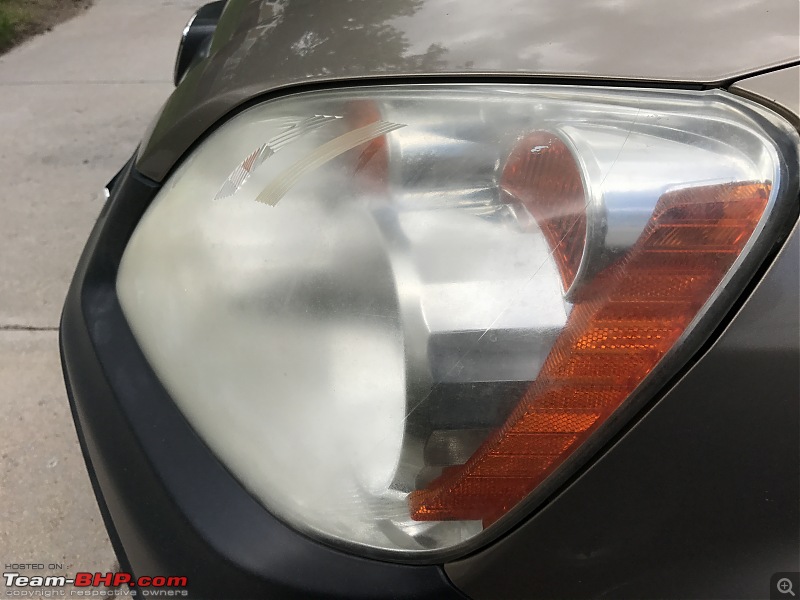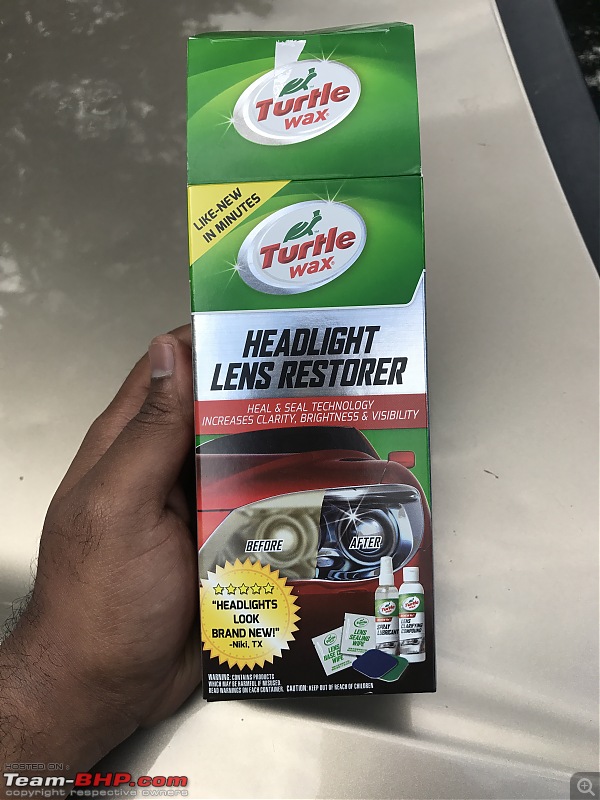Hello!
I'm writing a thread on this forum after a really long hiatus. The last thread I wrote was perhaps in 2013? A lot happened over the years, undergrad, work, work and work and moved abroad to pursue masters. I might have lost touch in writing on this forum, but bear with me as I narrate the tale of how I restored my car's hazy headlamps.
What is this about?
A car's front is seen as just a facade by some and as a face by many. Having a well maintained, shiny vehicle is very desirable and easy too. But, I wouldn't say the same for the headlamps. Being exposed to varying weather conditions over the years, a car's headlamps start to fade out and become hazy over the years, which can become an eyesore over the years. Hazy headlamps not just affect the aesthetics of the vehicle, they also tend to have a poor downroad light output.
What vehicle do I use?
I purchased a preowned 2007 Toyota Avalon Limited few months ago from a friend of mine. Having primarily driven a Toyota back in India, Toyota was the first brand that came to my mind when I set out to buy my first car here in the land of 50 states. I did temporarily own a classic 1999 Toyota Camry during the winter before I sold it and upgraded to this much more beefy and premium Avalon.
Why am I writing this?
I was really excited with the purchase of this vehicle, everything looked great inside out, except for the hazy headlamps that seemed to scatter the brilliant 6500k HID headlamps. It was bothering me, I tried out the safe toothpaste and toothbrush method, it hardly made a difference to my vehicle, but produced excellent results in my Uncle's Honda Odyssey.
I searched online for fixes and even new headlamp assemblies. They were priced out of my budget.

I started looking for headlamp restoration services and asked my local carwash chain for a quote. This is what I got.

Even though they offered a year's warranty, the $75 price tag seemed pretty steep, at least for a student like me!
I was in pursuit of finding a solution to the hazy headlamps whilst juggling between adulting, taking online classes, writing assignments, taking quizzes and of course, watching my favorite shows on Netflix

That's when I stumbled upon the DIY kits on Amazon. Browsed a bunch of products, shortlisted, read reviews of the product on Amazon and watched tutorials and results on youtube to get the whole picture. Most kits required power tools, but there was one kit that required strong fingers and forearm: Sylvania! This was the only kit that did not require a drill. I quickly ordered it for a mere $20 inclusive of taxes and waited for it to arrive.
The Kit:
The kit reached me in about 3 days, as this wasn't a prime fulfilled product and it was pretty simple.
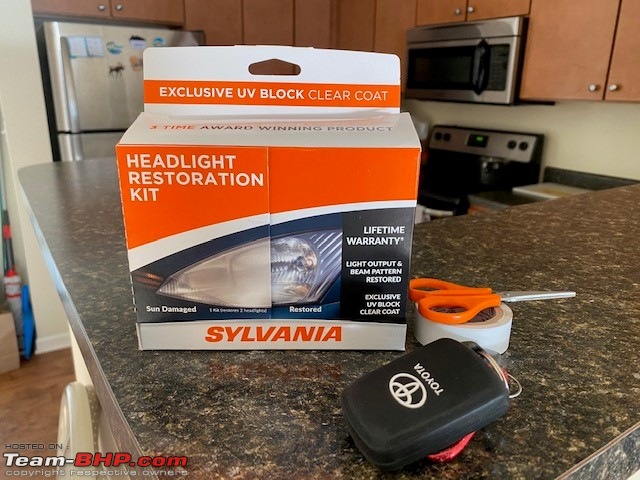
It had a variety of tools in it to get the headlamps back to looking like new.
- Surface activator
- 400 Grit Sandpaper
- 1000 Grit Sandpaper
- 2000 Grit Sandpaper
- Two soft towels
- Clarifying Compound
- Applicator cloth
- UV shield coating
- Vinyl gloves
- Instructions
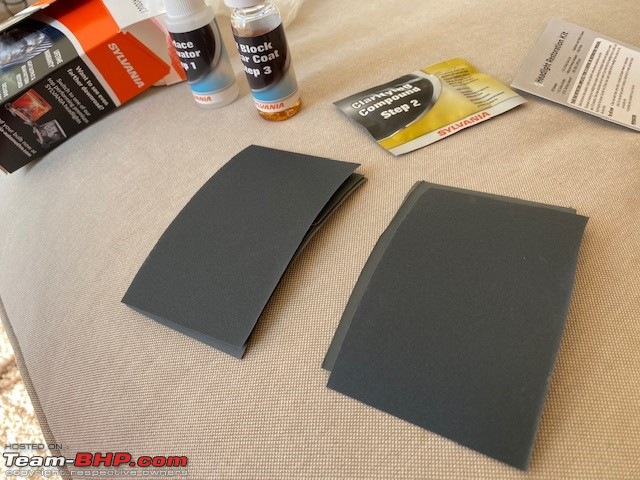
The Sandpapers they had given were all single papers. To use them on the two headlamps, I cut them into two smaller and equal sized papers.

For the masking tape, I had used the insultation tape that I had at home. I also took plenty of paper towel, two foldable chairs, a bucket full of water to get the process done.
The Process:
Step 1:
Step 1 is to prepare the vehicle for the procedure. I had moved my vehicle from my covered parking to an open area where there wasn't direct sunlight. It was easier to carry out the procedure as I started exactly at 5pm and it was relatively cool and pleasant 60 degrees. Set the chairs up next to both the headight, had my spotify playlist on shuffle and started washing the headlights and then applying the tape around the headlight assemblies.
This is how it looked before the process.  With the masking tape in place.
With the masking tape in place.  Step 2:
Step 2:
With the masking done, it was time to apply the surface activator. This is a crucial step where the surface activator removes all the damaged UV coat and softens the plastic. You can see the yellowish haze on the headlights run down after the surface activator is sprayed. The activator soaked the headlights for about a minute before I washed them off.
Step 3:
After washing and drying the headlamps, they were sanded with the 400 grit sandpaper. This seemed easy at first, but sanding the headlights with 5-6 minutes on each side, whilst watering them is a very tiring process. Wet Sanded both the headlights, washed and wiped them dry. Had to sand them till they became smooth. It was a painful process, but it seemed to have worked. The headlights became completely hazy and white. But this was a part of the process.
After sanding and drying with 400 Grit  Step 4:
Step 4:
This was another tiresome process! I had to repeat the same wet sanding process on both the headlamps for 5-10min each. But, this time it was with 1000 grit. I could see the scratches made by the 400 grit being evened out by the 1000 grit paper. It looked like it was getting better in this step.
After the 1000 grit sanding and drying.  Step 5:
Step 5:
When I thought this whole process was going to be easy, it was now when I was proved wrong! My hands were in agonizing pain from all that sanding. This was when I started questioning myself, why didn't I simply pay $75 for getting this work done. But, I wasn't giving up. So, I went on with the 2000 grit wet sanding and the results were very good. The headlamps were gaining some clarity here. But as soon as it was dried out, it went back to being hazy.
The result of the painful 2000 grit sanding 
Step 6:
Just when I thought I was all set with sanding, then came the clarifying compound application. I had to apply the clarifying compound on the white towel and apply it on the headlamps in circular motion for another 5 minutes! I almost gave up at this point, but the determination to have better looking headlamps had me going.
After applying clarifying compound 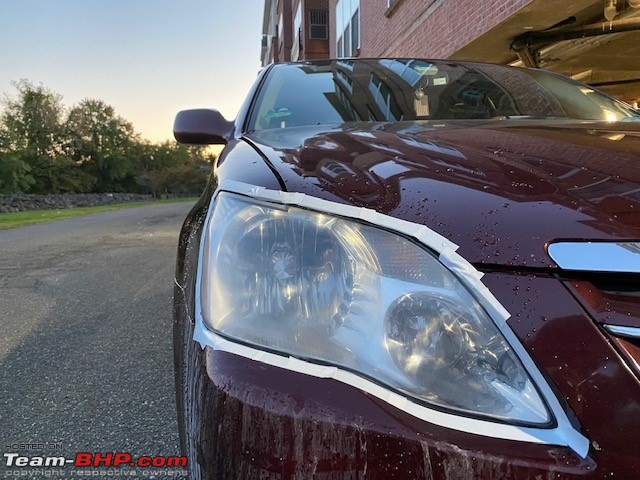 My roommate helping me wash the clarifying compound off
My roommate helping me wash the clarifying compound off  Step 7:
Step 7:
This was the 2nd last step, I had to spary the surface activator all over the headlamps and rinse it off before the final step. After drying, it was left all smooth, but still a bit hazy.
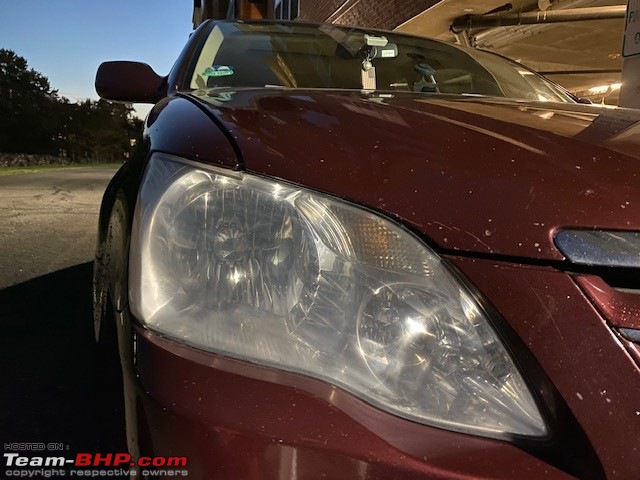 Final step:
Final step:
This is the step where you see the results of your hardwork. This is where I knew it was worth spending an hour and fifty nine minutes on a cool fall evening on restoring the headlamps.
The UV block coating is to be applied with long strokes, overlapping the previous stroke from end to end. It is easy to do, but we need to make sure that we do not leave any gaps.
Once the tapes were removed and the UV block coating was applied, the headlamps went to looking like brand new! I'll let the pictures do the talking!
The UV block coating before it was applied.  Voila! The astonishing result!
Voila! The astonishing result! 
What do you guys think of this? Has anyone used this kit previously? If so, how has it's performance been over time? I'm hoping to keep this thread alive with updates on how the restoration fares over time

 (59)
Thanks
(59)
Thanks

 (12)
Thanks
(12)
Thanks
 (3)
Thanks
(3)
Thanks
 (2)
Thanks
(2)
Thanks
 (1)
Thanks
(1)
Thanks
 (1)
Thanks
(1)
Thanks
 (3)
Thanks
(3)
Thanks
 (1)
Thanks
(1)
Thanks






















